Transform your garden into a vertical paradise faster than you ever imagined possible. We’ve all stood in our yards dreaming of lush green walls and stunning natural screens but dreaded the years of waiting for traditional plants to mature. That’s where fast-growing climbing plants become your secret weapon for instant garden gratification.
Fast-growing climbers aren’t just about speed – they’re about maximizing your outdoor space and creating dramatic focal points that deliver results in months rather than years. Whether you’re looking to hide an unsightly fence or create a living privacy screen these vigorous vines can transform bare surfaces into stunning green showcases.
We’ve discovered the game-changing varieties that’ll have your neighbors asking for your gardening secrets. From morning glories that’ll blanket your trellis in a single season to hardy clematis that returns bigger and better each year these climbing champions prove that patience isn’t always a virtue in gardening.
Fast-Growing Annual Climbing Vines for Instant Coverage
Annual climbing vines offer the fastest transformation for gardens needing immediate visual impact. These vigorous growers can reach full coverage within a single growing season and provide stunning displays from spring through frost.
Morning Glory
Morning glories deliver spectacular trumpet shaped blooms that open each dawn in vibrant blues, purples, pinks, and whites. We’ve seen these annual climbers reach heights of 10 to 15 feet in just one season when planted in full sun locations. Their heart shaped leaves create dense foliage coverage perfect for screening unsightly areas or covering chain link fences.
Plant morning glory seeds directly in warm soil after the last frost date for your region. These fast climbers germinate within 7 to 10 days and begin their rapid ascent up trellises, arbors, or support structures. Water them regularly during establishment but avoid overwatering as they prefer slightly dry conditions once mature.
Sweet Peas
Sweet peas produce clusters of delicately fragrant flowers in soft pastels and bold colors while climbing 6 to 8 feet tall during cool weather months. We recommend planting these annual vines in early spring when soil temperatures reach 45 degrees Fahrenheit. Their tendrils grip supports naturally and create beautiful cascading displays perfect for cutting gardens.
Choose climbing varieties like ‘Old Spice Mix’ or ‘Royal Mix’ for maximum height and flower production. Sweet peas thrive in cool temperatures and may slow growth during hot summer months in warmer climates. Provide afternoon shade in regions with intense summer heat to extend their blooming period.
Cardinal Climber
Cardinal climber showcases brilliant red trumpet flowers against deeply lobed foliage while reaching 10 to 20 feet in height during warm growing seasons. We’ve observed these heat loving annuals attract hummingbirds and butterflies throughout summer and fall months. Their fine textured leaves create an elegant backdrop for the vibrant scarlet blooms.
Start cardinal climber seeds indoors 6 to 8 weeks before the last frost or direct sow after soil warms to 60 degrees Fahrenheit. Nick the hard seed coat with a file before planting to improve germination rates. These vigorous climbers prefer full sun locations and well draining soil for optimal growth performance.
Perennial Climbing Plants That Establish Quickly
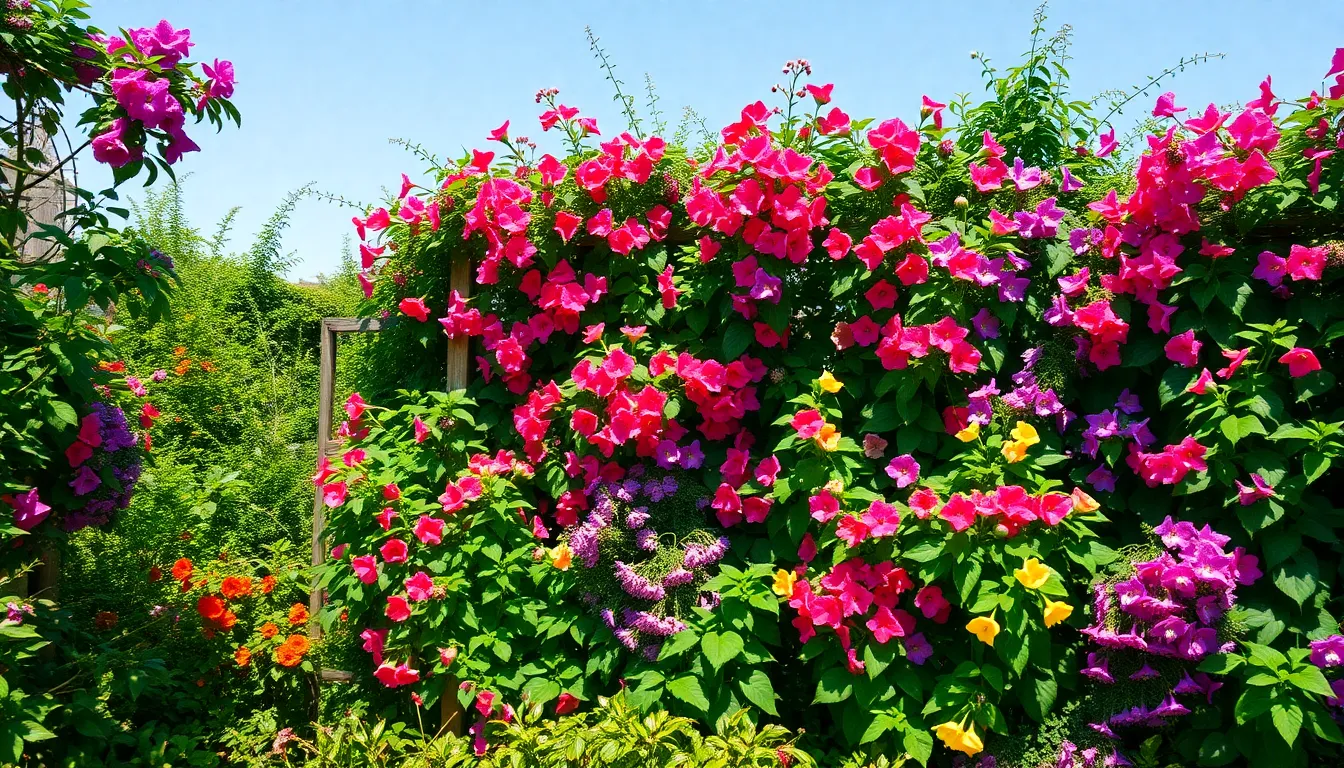
While annual climbers provide instant gratification, perennial varieties offer lasting value by returning stronger each season. These hardy climbers establish deep root systems and create permanent garden features that improve with age.
Honeysuckle
Honeysuckles deliver rapid coverage with their vigorous twining growth habit and fragrant blooms. We recommend these versatile climbers for gardeners seeking quick results, as they thrive in full sun to partial shade conditions. Their low maintenance requirements make them ideal for busy homeowners who want beautiful vertical displays without constant care.
Fragrant flowers appear throughout the growing season, attracting beneficial pollinators while providing natural privacy screening. The dense foliage fills spaces efficiently, creating lush green walls that return reliably each spring. Multiple Lonicera species offer different bloom colors and growth patterns to suit various garden designs.
Clematis
Clematis varieties cover about 300 species of mostly vigorous climbing plants that transform gardens with spectacular flowering displays. Popular cultivars like ‘Jackmanii’ and ‘Nelly Moser’ can reach 3 to 15 feet or more in a single growing season through their unique leaf stem twining mechanism.
Abundant flowers bloom in white, pink, purple, red, and bicolor combinations, creating stunning focal points on trellises and arbors. Well drained soil and full sun to partial shade conditions support optimal growth, though some varieties like C. armandii provide evergreen coverage year round. Most clematis species are deciduous but return with increased vigor each spring.
Trumpet Vine
Trumpet vines establish as vigorous woody climbers that can reach 30 to 40 feet using specialized aerial rootlets for surface adhesion. We’ve observed these hardy perennials quickly covering fences, walls, and trellises with dense foliage and striking trumpet shaped flowers.
Orange to red blooms attract hummingbirds throughout the summer months while tolerating various soil conditions and full sun exposure. Their aggressive growth habit makes them perfect for covering large structures rapidly, though regular pruning helps maintain desired boundaries. Many soil types support trumpet vine growth, making them adaptable choices for challenging garden locations.
Vegetable Climbers That Grow Rapidly
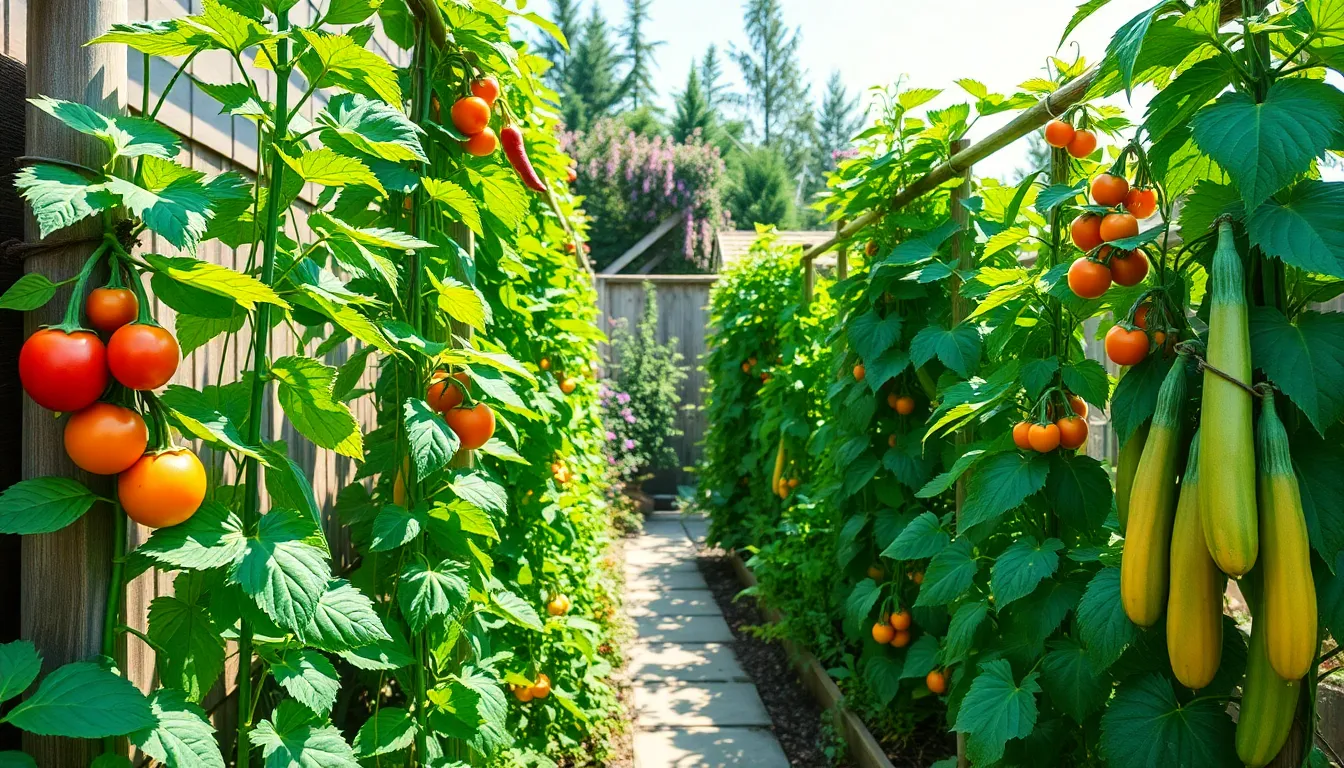
Beyond ornamental climbing plants, fast growing edible climbers offer both beauty and productivity for our vertical gardens. These vigorous vegetable climbers maximize space while delivering impressive harvests in record time.
Pole Beans
Pole beans rank among the fastest and most reliable climbing vegetables we can grow. Strong twining stems make these plants natural climbers that easily scale trellises, poles, or any vertical support structure. Varieties like ‘Blue Lake’, ‘Kentucky Wonder’, ‘Fortex’, and ‘Malibu’ demonstrate exceptional vigor and climbing ability.
These productive climbers mature relatively early compared to other climbing vegetables. Higher yields make pole beans superior to their bush counterparts for gardeners seeking maximum productivity from minimal space. Mature plants can reach 6 to 10 feet tall, creating living green walls that produce continuously throughout the growing season.
Cucumbers
Cucumbers naturally climb using specialized tendrils, making them ideal candidates for vertical growing systems. These fast growing vines adapt perfectly to trellises, fences, or tower structures. Heat tolerant varieties like ‘Diva’, ‘Beit Alpha’, and specially bred types such as ‘Japanese Climbing’ excel in vertical arrangements.
Vertical growing keeps cucumber fruits clean and straight while improving air circulation around plants. Most varieties mature within 50 to 70 days, delivering fresh harvests quickly. Small fruited varieties work particularly well for climbing systems, producing abundant crops without overwhelming support structures.
Squash and Gourds
Winter squash and certain gourds can be successfully trained to climb with proper support systems. These vigorous plants grow rapidly when provided with strong trellises capable of supporting their weight. Smaller varieties prove more suitable for vertical gardening since they place less stress on climbing structures.
Quick growth characterizes these climbing squash varieties when trained vertically rather than allowed to sprawl. Large fruits require sturdy support systems, but the space saving benefits make vertical training worthwhile. Proper support planning ensures successful cultivation of these productive climbing vegetables.
Fast-Growing Climbing Plants for Privacy Screens
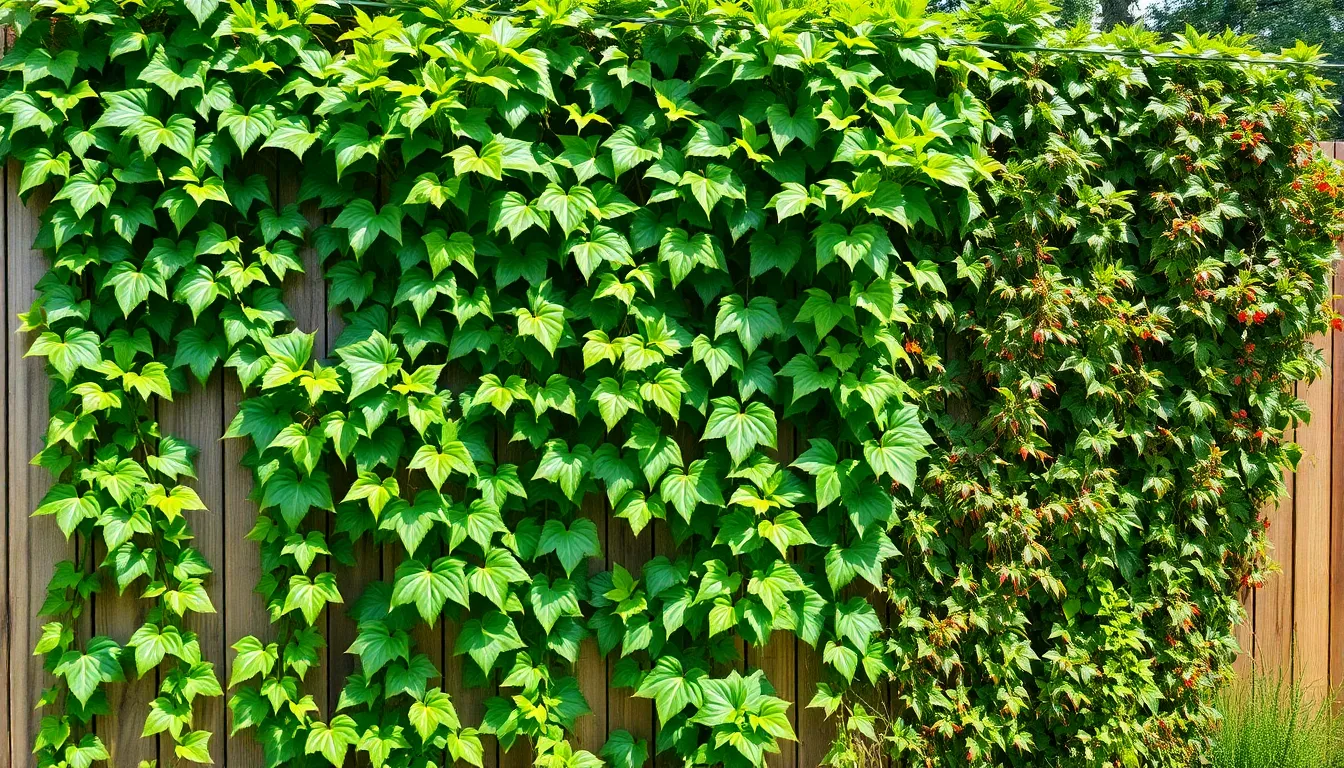
Creating effective privacy screens doesn’t have to take years when you choose the right fast growing climbing plants. We’ve identified three exceptional varieties that deliver rapid coverage while adding natural beauty to your outdoor spaces.
Virginia Creeper
Virginia Creeper transforms bare walls and fences into lush green screens with remarkable speed. This vigorous vine attaches itself to surfaces using small tendrils, eliminating the need for additional support structures. We appreciate how it adapts to various soil types and thrives in both full sun and partial shade conditions.
Dense foliage creates excellent year round privacy while requiring minimal maintenance from busy gardeners. The plant’s green leaves turn striking red in autumn, providing seasonal interest beyond its screening capabilities. Virginia Creeper grows rapidly enough to cover substantial areas within a single growing season, making it ideal for quick privacy answers.
Boston Ivy
Boston Ivy stands out as one of our top choices for large scale privacy screening projects. This self climbing powerhouse can reach heights up to 20 meters, making it perfect for covering house facades, tall fences, and extensive wall surfaces. We recommend it especially for gardeners seeking low maintenance answers that deliver professional looking results.
The vine’s ability to climb without structural support saves both time and installation costs. Green summer foliage provides excellent privacy coverage, while brilliant scarlet fall colors add spectacular seasonal beauty. Small yellow flowers attract beneficial pollinators like bees, contributing to garden network health while maintaining dense screening throughout the growing season.
American Bittersweet
American Bittersweet combines rapid privacy screening with ornamental appeal through its vigorous woody vine structure. This fast growing climber covers fences quickly while producing showy clusters of orange red berries in autumn. We find it particularly valuable for gardeners wanting both functional screening and decorative seasonal interest.
The vine requires some climbing support such as trellises or existing fences but adapts well to full sun or partial shade conditions. Drought tolerance once established makes it suitable for low water gardens and challenging growing conditions. Dense growth patterns create effective privacy screens while the colorful autumn berries provide wildlife food and visual appeal long after other plants have finished their seasonal display.
Quick-Climbing Flowering Vines for Garden Beauty
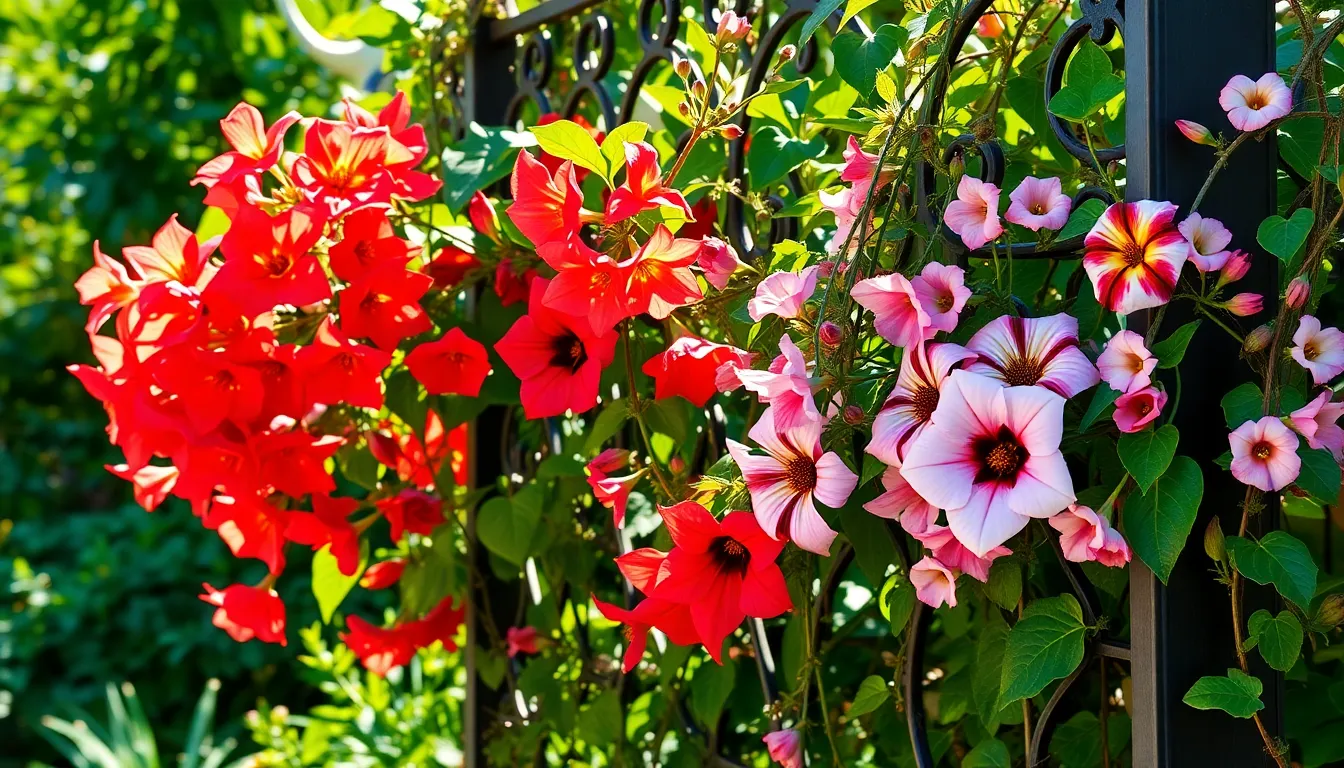
When we want stunning blooms combined with rapid vertical growth, these exceptional flowering vines deliver both beauty and impressive climbing speed.
Mandevilla
Mandevilla transforms any garden structure into a tropical paradise with its large trumpet-shaped flowers in vibrant pink, red, or white colors. This vigorous climber grows rapidly in warm climates and efficiently covers trellises or walls with minimal effort from gardeners.
Full sun exposure and well-drained soil create the perfect growing conditions for mandevilla vines to thrive. Support structures like arbors or pergolas become essential since this vine requires something to climb as it reaches for height.
Growing mandevilla as an annual works well in cooler regions, while gardeners in warmer zones can enjoy its perennial nature. We recommend overwintering potted specimens indoors in areas with harsh winters to preserve these beautiful vines for the following season.
Black-Eyed Susan Vine
Black-Eyed Susan Vine produces cheerful, bright flowers with distinctive black centers that instantly catch attention in any garden space. Orange, yellow, or white blooms create stunning displays as this fast climber vigorously scales fences, trellises, or arbors throughout the growing season.
Partial to full sun locations suit this vine perfectly, paired with moderate watering schedules that prevent both drought stress and waterlogged conditions. Quick establishment makes Black-Eyed Susan Vine ideal for gardeners seeking immediate visual impact.
Annual growth patterns characterize this vine in most regions, though self-seeding often brings pleasant surprises the following year. We find that allowing some flowers to go to seed creates natural propagation for continuous garden beauty.
Moonflower
Moonflower captivates evening gardens with its large, fragrant white flowers that open as darkness falls, creating magical nighttime displays. This fast-growing vine reaches impressive heights of 10 to 15 feet quickly during a single growing season.
Full sun and well-drained soil provide optimal growing conditions for moonflower vines to achieve their remarkable growth rates. Evening fragrance becomes most pronounced near seating areas, patios, or bedroom windows where we can fully appreciate this unique characteristic.
Arbors, trellises, or fence structures offer perfect support for moonflower’s climbing habit while showcasing its spectacular blooms. We particularly value this vine for creating romantic garden spaces that come alive after sunset with both visual beauty and intoxicating fragrance.
Fast-Growing Climbing Plants for Indoor Spaces
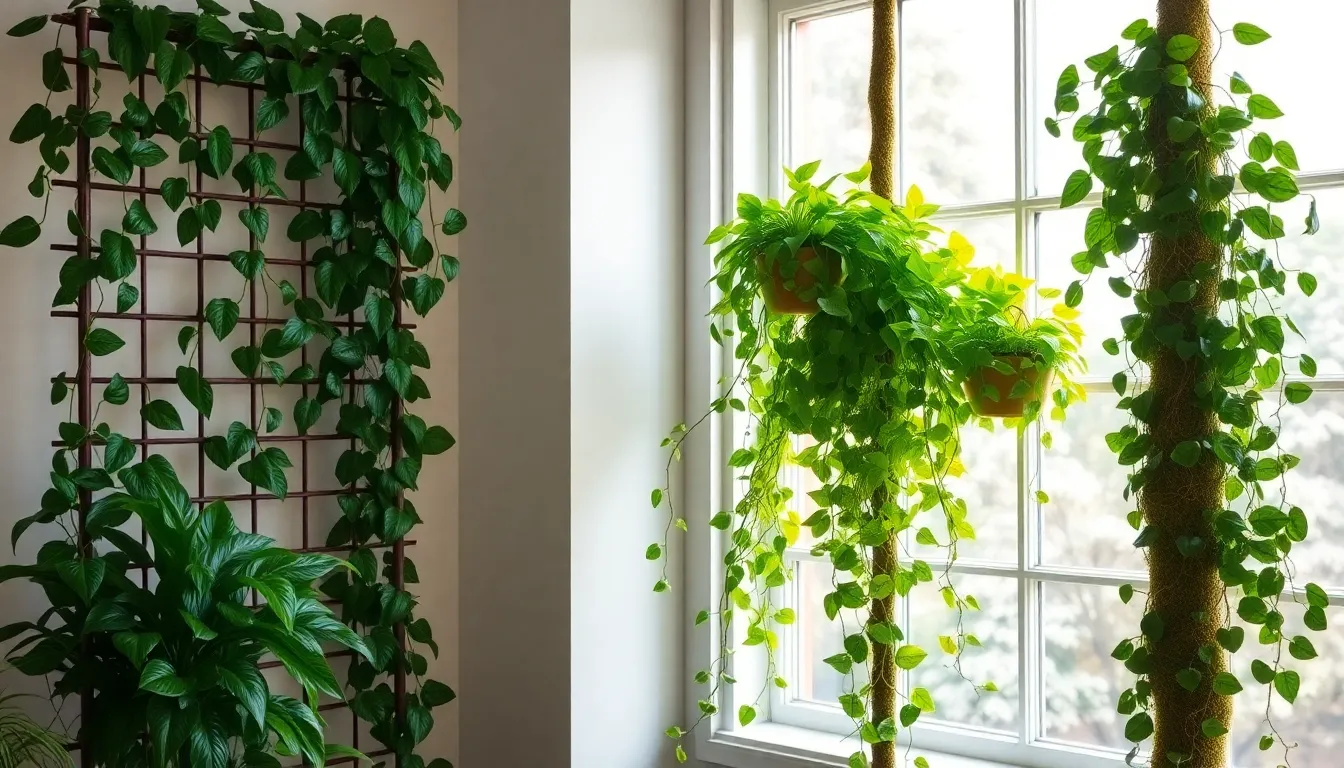
We’re bringing our fast-growing climbing expertise indoors, where these versatile plants create stunning vertical displays while thriving in contained environments. Indoor climbing plants offer us the perfect solution for maximizing our interior space while adding natural beauty to our homes.
Pothos
Pothos stands out as our top choice for rapid indoor climbing growth, reaching impressive vine lengths up to 12 feet in optimal conditions. We love how this low maintenance champion tolerates everything from low light corners to bright indirect sunlight, making it perfect for any room in our home. Watering becomes effortless since we only need to water when the soil feels dry to the touch.
Training pothos on moss poles or trellises transforms our vertical spaces into lush green walls with minimal effort. We must remember that pothos contains compounds toxic to pets, so we recommend keeping these climbing beauties out of reach from curious cats and dogs.
Philodendron
Philodendron delivers another excellent fast growing option that we can easily train to climb our indoor supports and structures. We find philodendrons prefer indirect light conditions and respond well to moderate watering schedules that keep the soil consistently moist. Growing habits mirror those of pothos, though we notice fascinating differences in leaf shapes and sizes depending on the exact variety we choose.
Indoor vertical gardening becomes incredibly rewarding when we provide philodendrons with proper climbing supports like bamboo poles or wire frames. We appreciate how these adaptable climbers fill our interior spaces with tropical greenery while requiring minimal daily attention.
English Ivy
English ivy grows at a steady medium pace indoors, offering us reliable coverage for our vertical gardening projects. We’ve discovered that bright light conditions work best, though our ivy plants adapt surprisingly well to fluorescent lighting in shadier interior areas. Soil preferences lean toward slightly acidic, well draining mixtures that prevent root rot and encourage healthy climbing growth.
Weekly watering works perfectly when we allow the soil surface to dry between waterings without letting it become completely parched. We consider English ivy a classic choice for indoor vertical coverage, especially when we want traditional elegance in our home climbing displays.
Essential Growing Tips for Maximum Climbing Speed
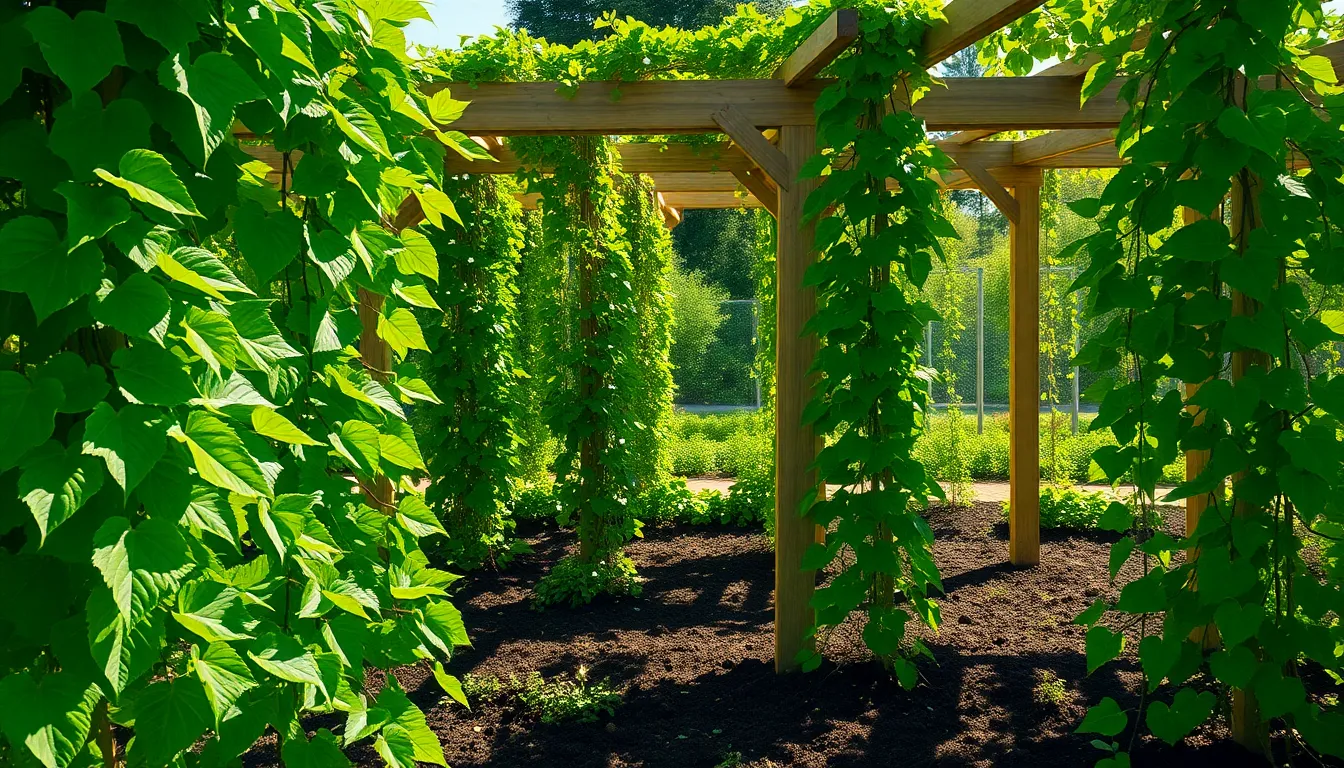
We’ll accelerate your climbing plants’ growth potential with these proven techniques that maximize coverage speed and overall vigor.
Proper Soil Preparation
Create nutrient-rich soil foundations by incorporating organic matter like compost into your existing garden beds. Well-drained soil prevents waterlogging while supporting vigorous root development that directly impacts climbing speed. We recommend testing soil pH levels to ensure they fall between 6.0-7.0, as most climbing plants thrive in this slightly acidic to neutral range.
Enhance soil fertility with aged compost or well-rotted manure before planting your climbers. Rich organic matter improves moisture retention capabilities while providing essential nutrients throughout the growing season. Proper drainage remains crucial since soggy conditions can stunt root growth and slow overall plant development.
Optimal Watering Techniques
Maintain consistent moisture levels especially during the establishment phase when roots are developing their foundation. Deep, infrequent watering encourages robust root systems that support faster vertical growth compared to shallow, frequent irrigation. We’ve found that morning watering gives plants time to absorb moisture before heat stress occurs.
Install drip irrigation systems or use soaker hoses to deliver water directly to root zones without wetting foliage. This targeted approach reduces fungal disease risks while ensuring efficient water uptake. Consistent moisture during dry spells keeps climbing plants growing steadily rather than entering survival mode that slows development.
Support Structure Requirements
Provide sturdy support systems like trellises, arbors, or garden arches that can handle your climber’s mature weight and size. We match support types to plant characteristics: thin wires work best for twining vines, while rough surfaces or mesh help plants with tendrils or aerial roots establish secure holds.
Install supports before planting to avoid disturbing established root systems later. Strong frameworks encourage upward growth patterns from day one, maximizing your climber’s natural tendency to reach for light. Regular training and gentle tying guide growth direction while preventing wind damage that can set back development.
Choose appropriate support heights based on your exact climbing plant’s mature size potential. Inadequate support limits growth and forces plants to sprawl horizontally rather than climb vertically as intended.
Common Mistakes That Slow Down Climbing Plant Growth
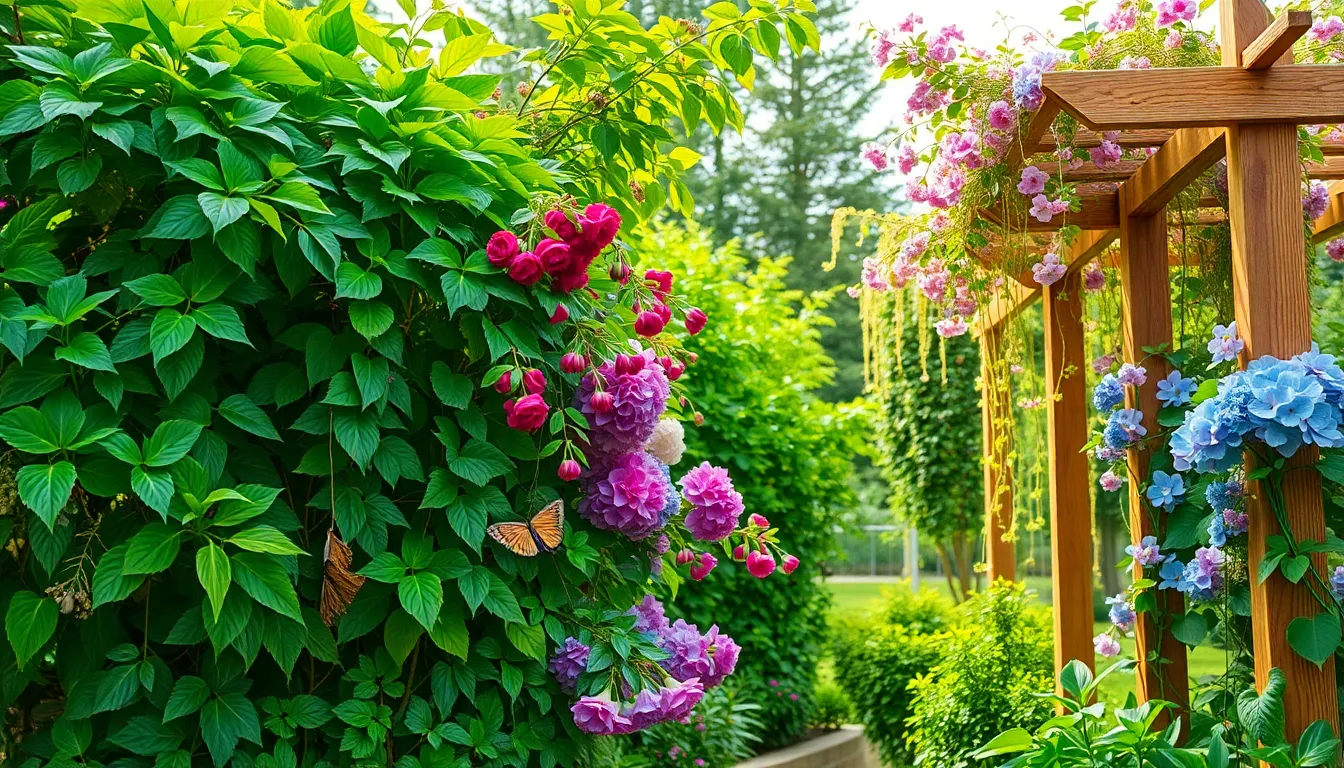
Even the fastest climbing plants can struggle when we make these critical growing mistakes. Understanding these common pitfalls helps us avoid setbacks that turn vigorous climbers into disappointing disappointments.
Inadequate Support Systems
Support structures make or break climbing plant success in our gardens. Without proper trellises, arbors, or sturdy fences, vines trail on the ground instead of reaching their potential heights. We’ve seen Akebia quinata fail to reach its impressive 30-foot height when gardeners underestimate the strength needed to support woody climbers.
Strong materials like cedar, metal, or composite lumber provide lasting support for vigorous growers. Flimsy plastic trellises collapse under the weight of mature vines like climbing hydrangeas, which can reach 50 feet tall. Installing support systems before planting gives new climbers immediate direction and prevents damage from wind or heavy growth.
Wide spacing between support elements allows air circulation while providing multiple attachment points. Cobaea scandens uses self-twining tendrils that need horizontal supports spaced 6 to 12 inches apart for optimal climbing. Regular maintenance of support structures prevents costly replacements and protects our climbing plant investments.
Poor Planting Location
Location determines whether our climbing plants thrive or merely survive in the garden. Light conditions directly impact growth rates, with most fast climbers requiring full sun for maximum vigor. Planting sun-loving varieties like Cup and Saucer Vine in shaded areas dramatically reduces their growth potential from 20 feet to just a few feet.
Soil quality affects root development and nutrient uptake throughout the growing season. Fertile, well-draining soil feeds hungry climbers like morning glory and cardinal climber that need consistent nutrition for rapid growth. Clay or sandy soils without organic matter amendments starve plants of essential nutrients needed for vigorous climbing.
Moisture levels must match each plant’s exact requirements for optimal performance. Star jasmine and wisteria prefer consistent soil moisture but not waterlogged conditions that cause root rot. We’ll see stunted growth when we plant moisture-loving climbers in dry locations or drought-tolerant varieties in constantly wet soil.
Incorrect Pruning Practices
Timing pruning incorrectly can set back climbing plants for entire growing seasons. Over-pruning removes the energy-storing stems that fuel rapid spring growth in perennial climbers like clematis. We often see gardeners cut back vigorous growers too severely, thinking more pruning equals better growth.
Different climbing plants require exact pruning approaches for maximum growth potential. Spring-flowering climbers like climbing hydrangeas need pruning immediately after blooming to avoid removing next year’s flower buds. Pruning these plants in fall or winter eliminates the spectacular blooms that make them garden standouts.
Wrong pruning techniques damage plant structure and reduce overall vigor in climbing specimens. Making cuts too far from nodes or buds creates dead wood that invites disease and pests. Sharp, clean tools and proper cutting angles promote healing and redirect energy into new growth rather than recovery from poor cuts.
Seasonal Care for Fast-Growing Climbing Plants
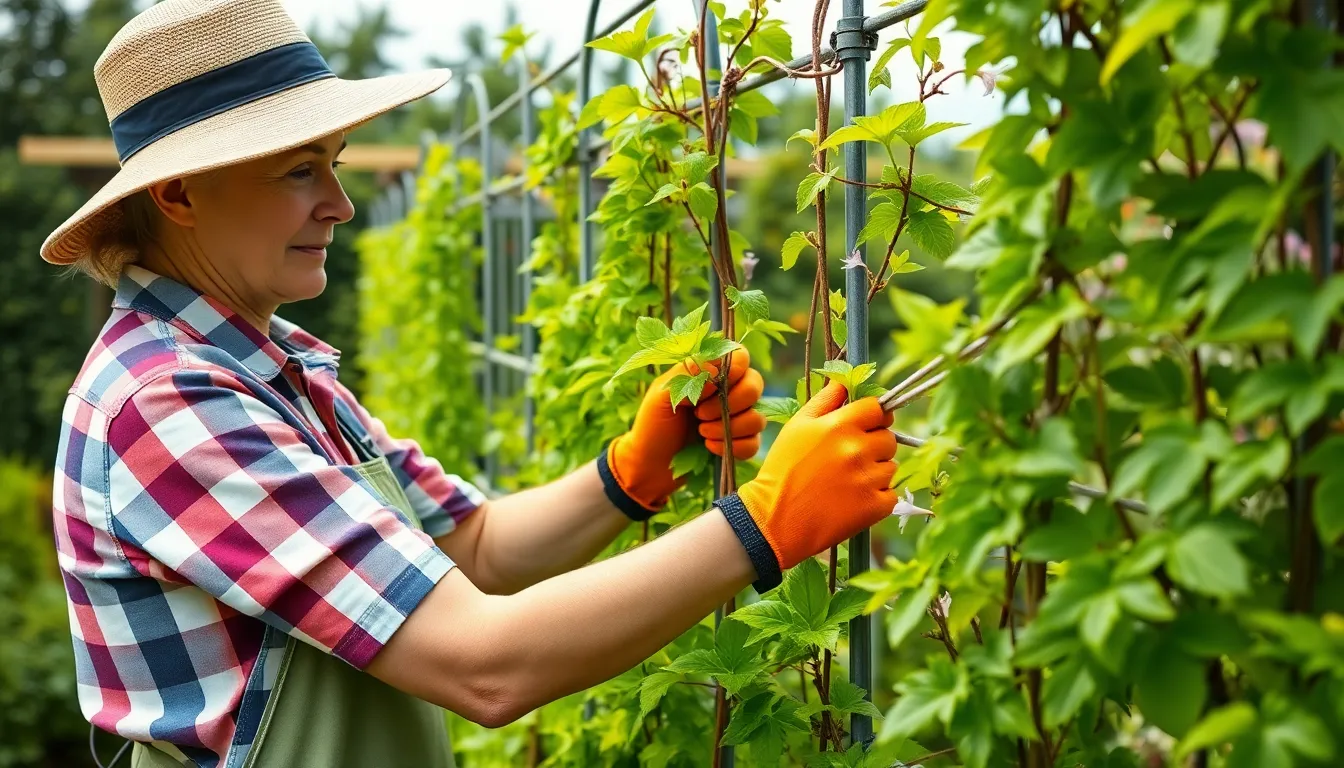
Proper seasonal care ensures our fast-growing climbing plants reach their full potential while maintaining healthy, vigorous growth throughout the year. We’ll break down the essential tasks for each season to help you maximize your climbing plants’ performance.
Spring Planting Guidelines
Plant climbing varieties during spring or autumn when cool, moist weather conditions support better establishment. We recommend positioning new plants 11 to 17 inches away from support structures, allowing adequate water access to developing root systems. Well-draining, fertile soil provides the foundation for rapid growth, particularly in sunny, sheltered locations that protect tender new shoots.
Choose locations based on your exact climbing plant requirements. Some varieties like jasmine and rambling roses tolerate partial shade conditions, while others demand full sun exposure for optimal performance. We’ve found that proper soil preparation makes the difference between struggling plants and thriving climbers that quickly cover their intended spaces.
Install support structures before planting to avoid disturbing established root systems. Russian vine (Fallopia baldschuanica) can reach impressive heights of 12 meters with a 4-meter spread, requiring substantial support from the beginning. Planning ahead prevents future complications and ensures your climbers have adequate framework for their vigorous growth patterns.
Summer Maintenance Tasks
Water regularly during dry spells, focusing irrigation at the soil base rather than overhead spraying. This targeted approach reduces fungal problems while delivering moisture directly to root zones where it’s needed most. We recommend deep, consistent watering sessions that encourage robust root development in fast-growing varieties.
Tie new shoots to supports using soft twine, securing them loosely to accommodate continued growth. This gentle guidance directs vigorous climbers like Clematis tangutica along their intended paths while preventing wind damage to tender stems. Regular tying sessions keep growth organized and maximize coverage of support structures.
Deadhead climbing roses regularly to encourage continuous flowering throughout the growing season. Removing spent blooms redirects energy into producing new flowers rather than seed development. We’ve observed that consistent deadheading can extend blooming periods significantly in varieties that naturally produce multiple flush cycles.
Prune immediately after flowering to maintain strong framework structures while removing dead or diseased material. Summer pruning focuses on thinning side shoots and controlling overall size without sacrificing next season’s flowering potential. This selective approach keeps vigorous growers like rambling roses within manageable bounds while promoting healthy air circulation.
Fall and Winter Preparation
Apply mulch around plant bases during fall to conserve soil moisture and protect root systems from temperature fluctuations. Organic mulches break down over time, adding valuable nutrients to soil while maintaining consistent growing conditions. We recommend 2 to 3 inches of mulch extending beyond the drip line for maximum effectiveness.
Remove dead or diseased foliage completely to reduce pest and disease pressure during dormant months. This sanitation practice prevents problems from overwintering and emerging as major issues in spring. Thorough cleanup also improves air circulation around climbing structures and reduces hiding places for harmful insects.
Secure all climbers firmly to their supports before winter weather arrives. Strong winds can damage inadequately tied plants, breaking stems or pulling entire vines away from support structures. We check all ties and add reinforcement where needed, using weather-resistant materials that won’t deteriorate during harsh conditions.
Plan hard pruning for vigorous climbers like clematis in early spring to maintain manageable size and encourage abundant flowering. This timing allows plants to direct energy into new growth and flower production rather than maintaining excessive vegetative material. Proper winter preparation sets the stage for another season of impressive climbing plant performance.
Conclusion
Fast-growing climbing plants offer us the perfect solution for transforming our outdoor spaces without the lengthy wait that traditional gardening often requires. Whether we’re seeking immediate privacy screens vibrant flowering displays or productive vertical gardens these vigorous climbers deliver impressive results in just one growing season.
The versatility of these plants allows us to tackle various gardening challenges from covering unsightly structures to maximizing limited space. With proper care and attention to seasonal needs we can enjoy lush green walls colorful blooms and even fresh harvests while creating stunning focal points that enhance our property’s overall appeal.
By choosing the right varieties for our exact climate and growing conditions we’re investing in garden answers that provide both instant gratification and long-term beauty. These remarkable plants prove that dramatic garden transformations are well within our reach.
Frequently Asked Questions
What are the fastest-growing climbing plants for quick garden transformation?
Morning glories, sweet peas, and cardinal climbers are excellent annual options that can reach 10-20 feet in a single season. For perennials, honeysuckle, clematis, and trumpet vines establish quickly and return stronger each year. These plants provide immediate visual impact and can transform bare spaces within months.
How tall can fast-growing climbing plants reach in one season?
Annual climbers like morning glories typically reach 10-15 feet, while cardinal climbers can grow 10-20 feet in a single season. Sweet peas usually climb 6-8 feet. Perennial varieties like Boston Ivy can eventually reach up to 20 meters, though they may take 2-3 years to achieve maximum height.
Which climbing plants work best for creating privacy screens?
Virginia Creeper, Boston Ivy, and American Bittersweet are exceptional for privacy screening. Virginia Creeper adapts to various conditions and provides dense coverage, while Boston Ivy quickly covers large areas. American Bittersweet offers both screening and ornamental berries, making them practical and attractive privacy solutions.
Can I grow edible climbing plants for vertical gardens?
Yes! Pole beans like ‘Blue Lake’ and ‘Kentucky Wonder’ are fast-growing and productive. Cucumbers naturally climb and mature quickly, while winter squash and gourds can be trained to climb with proper support. These edible climbers maximize growing space while providing impressive harvests.
What climbing plants thrive indoors?
Pothos, Philodendron, and English Ivy are excellent indoor climbers. Pothos can reach up to 12 feet and tolerates various light conditions. Philodendrons are easily trained to climb and add tropical appeal. English Ivy provides reliable coverage and adapts well to different indoor lighting conditions.
When is the best time to plant fast-growing climbing plants?
Spring and autumn are ideal planting times for most climbing plants. Spring planting allows the full growing season for establishment, while autumn planting gives roots time to develop before winter. Avoid planting during extreme heat or frost periods for best establishment results.
How do I support fast-growing climbing plants properly?
Install sturdy trellises, arbors, or wire supports before planting. Ensure structures can handle the mature weight of your chosen climber. Use soft ties to attach young growth, and regularly check that supports remain secure. Heavy climbers like winter squash need particularly robust support systems.
What are common mistakes when growing climbing plants?
Inadequate support systems, incorrect pruning timing, and poor soil preparation are common issues. Avoid over-watering, which can cause root rot, and don’t neglect regular maintenance like deadheading spent flowers. Also, ensure proper spacing to prevent overcrowding and competition for nutrients.
How do I care for climbing plants throughout the seasons?
Spring: Plant new climbers and apply mulch. Summer: Water regularly and deadhead flowers. Fall: Prune as needed and prepare for winter. Winter: Apply protective mulch, remove dead foliage, and secure climbers to supports. Regular seasonal maintenance ensures healthy growth and longevity.







